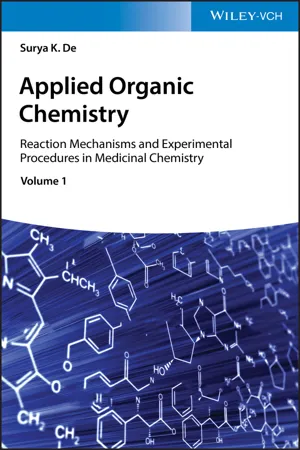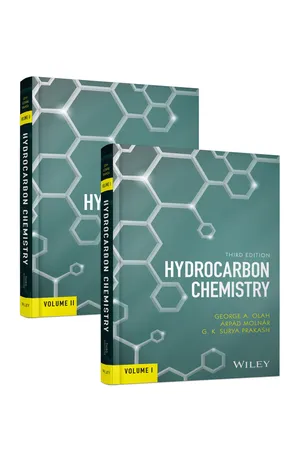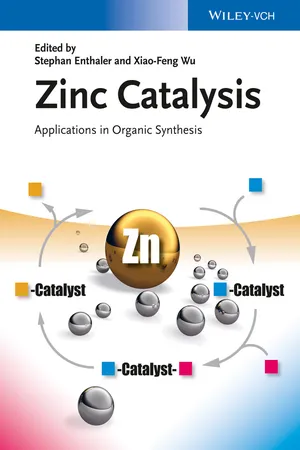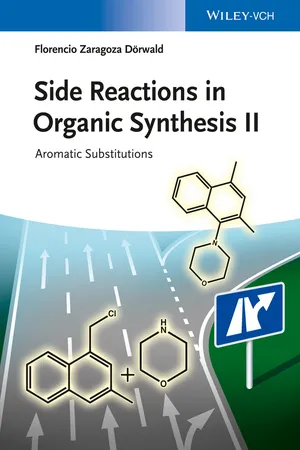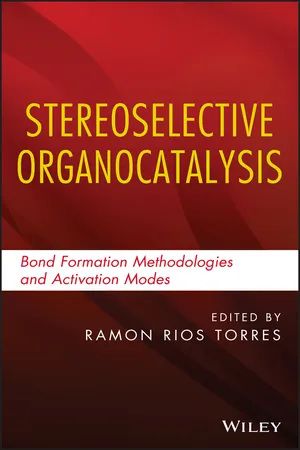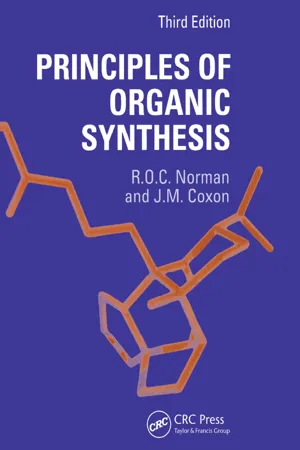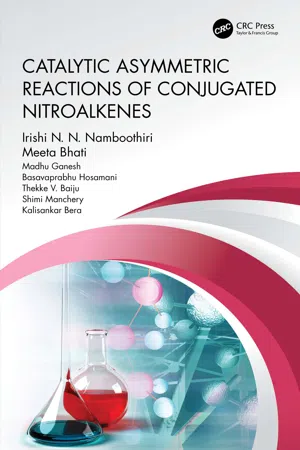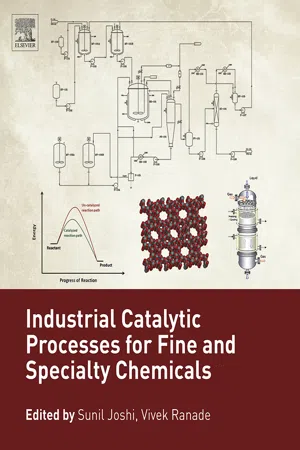Chemistry
Friedel Crafts Acylation
Friedel Crafts Acylation is a chemical reaction that involves the addition of an acyl group to an aromatic compound. This reaction is catalyzed by a Lewis acid, typically aluminum chloride, and requires the use of an acylating agent such as an acid chloride or anhydride. The resulting product is a substituted aromatic compound with a carbonyl group attached.
Written by Perlego with AI-assistance
Related key terms
Related key terms
1 of 4
Related key terms
1 of 3
8 Key excerpts on "Friedel Crafts Acylation"
- eBook - ePub
Applied Organic Chemistry
Reaction Mechanisms and Experimental Procedures in Medicinal Chemistry
- Surya K. De(Author)
- 2020(Publication Date)
- Wiley-VCH(Publisher)
[ 1, 2 ]. The Friedel–Crafts alkylation is still one of the widely studied and most utilized reactions in organic synthesis even after more than 143 years of its discovery. This reaction has the great versatility in scope and applicability to continue its crucial role in the synthesis of more and more complex molecules [3-67]. After more than a century, the asymmetric version on this reaction has been developed [ 34,35,38,40–42,45,46,51,52,55 ]. Several catalysts such as carbon monoxide [ 9 ], Sc(OTf) 3 [ 12, 17 ], Cu(OTf) 2 [ 13, 15 ], Zn(II)‐complex [ 21 ], In(III)‐salts [ 22 ], lanthanide triflates [ 23, 25 ], gold‐catalyst [ 24 ], FeCl 3 [ 26 ], and biocatalyst [ 53 ] have been employed on this reaction. Friedel–Crafts acylation Friedel–Crafts alkylation Mechanism For the Friedel–Crafts acylation, the electrophile is an acylium ion that is formed by a reaction between an acid chloride and an aluminum chloride as shown in the mechanism below. Step 1 : The initial step is the coordination between acyl chloride and AlCl 3 (complexation). Step 2 : The Lewis acid (AlCl 3) abstracts the chloride from acyl chloride to form an electrophilic acylium and a tetrachloride aluminum anion. Step 3 : An aromatic electrophilic substitution reaction results in a cationic intermediate with the loss of aromaticity. Step 4 : Deprotonation with aluminum anion ensures the - eBook - ePub
- George A. Olah, Arpad Molnar, G. K. Surya Prakash(Authors)
- 2017(Publication Date)
- Wiley(Publisher)
8 AcylationThe acylation of aromatic hydrocarbons was first described by Friedel and Crafts in 1877.1 Since then the reaction has been widely and thoroughly studied. It is one of the most important reactions in synthetic organic chemistry and a widely applied method to prepare aromatic ketones. It is also of considerable practical significance in the chemical industry2 since the products are intermediates in the manufacture of fine chemicals and other intermediates. Related topics, which include the Hueben–Hoesch reaction and aldehyde synthesis (formylation of aromatics), and the acylation of aliphatic compounds, in contrast, are less important, and consequently, will be treated accordingly. The acylation of aromatic2 – 10 and aliphatic compounds10–13 and the related processes10,14–18 are covered in reviews, and discussions of acylations can be found in other review papers about the use of homogeneous and heterogeneous electrophilic catalysts.19,208.1 Acylation of Aromatics
8.1.1 General Characteristics
Friedel–Crafts acylation is an electrophilic aromatic substitution to afford ketones by replacing one of the hydrogens of an aromatic ring. Carboxylic acid derivatives, characteristically acid halides and anhydrides, serve as acylating agents, and Lewis acid metal halides are the characteristic catalysts required to induce the transformation. Esters, in general, are not satisfactory reagents since they give both alkyl- and acyl-substituted products.In Friedel–Crafts acylation of aromatics with acid chlorides and Lewis acid metal halides, the reactive electrophile is considered to be formed in the interaction of the reagent and the catalyst. First the highly polarized donor–acceptor complex 1 is formed, which can further give other complexes and ion pairs.21 The various possible intermediates are depicted in Scheme 8.1 . Spectroscopic and kinetic data show the presence of these species in the reaction mixture. The scheme includes acyl cation 2, which is usually regarded as the reacting species in aromatic Friedel–Crafts acylations and forms the σ complex upon interacting with the aromatic compound.6,22,23 - eBook - ePub
Zinc Catalysis
Applications in Organic Synthesis
- Stephan Enthaler, Xiao-Feng Wu, Stephan Enthaler, Xiao-Feng Wu(Authors)
- 2015(Publication Date)
- Wiley-VCH(Publisher)
4 Zinc-Catalyzed Friedel–Crafts ReactionsYonghai Hui, Lili Lin, Xiaohua Liu and Xiaoming Feng4.1 Introduction
Since its discovery in 1877 by Friedel and Crafts[1], the substitution of aromatic or aliphatic substrates with various alkylating agents in the presence of Lewis acid is called the Friedel–Crafts alkylation [2]. A closely related reaction is the introduction of a keto group into an aromatic or aliphatic substrate by using an acyl halide or anhydride in the presence of a Lewis acid catalyst, called the Friedel–Crafts acylation (Scheme 4.1 ). Benzenes, indoles, pyrroles, and furans have been usually used as the nucleophilic substrates in Friedel–Crafts reactions (Figure 4.1 ). After over 130 years of development, Friedel–Crafts reactions have become one of the most important carbon–carbon bond-forming reactions in organic and medical synthesis.Friedel–Crafts reactions.Scheme 4.1Representative Friedel–Crafts nucleophilic substrates.Figure 4.1Zinc is the twenty-fourth most abundant element in the earth's crust. Catalysts based on zinc as a central metal take a key place in Friedel–Crafts reactions and considerable progress has been made in recent years. In the following text, the main achievements in this field of Friedel–Crafts reactions are summarized. Various Friedel–Crafts reactions catalyzed by zinc salts or their complexes are covered.4.2 Friedel–Crafts Acylation
Readily available zinc oxide is low cost, noncorrosive, and nonhygroscopic. As a solid-phase catalyst, it can catalyze the Friedel–Crafts acylation of electron-rich aromatic compounds with acyl chlorides under solvent-free conditions at room temperature, affording the corresponding ketones in 50–98% yields (Scheme 4.2 a) [3]. The products and the catalyst can be easily separated through filtering, and no chromatographic separation is needed to get the most spectra-pure products. The catalyst, zinc oxide, can be easily recovered by simple washing with dichloromethane and efficiently reused for at least three further cycles without loss of efficiency. Mechanistically, it seems that ZnCl2 is the true catalyst generated in situ - eBook - ePub
Side Reactions in Organic Synthesis II
Aromatic Substitutions
- Florencio Zaragoza Dörwald(Author)
- 2014(Publication Date)
- Wiley-VCH(Publisher)
4 Electrophilic Acylation of Arenes4.1 General Aspects
The acylation of arenes and heteroarenes with electrophilic acylating reagents, in particular the Lewis acid-mediated version, is called after their developers, the Friedel–Crafts acylation (Scheme 4.1 ). This reaction gives quick access to a large variety of aromatic ketones, and is one of the most important C–C bond-forming reactions. In most instances, stoichiometric amounts of AlCl3 are required, because the products deactivate one equivalent of Lewis acid. Stoichiometric amounts of other Lewis acids (TiCl4 , SnCl4 , or FeCl3 ), trifluoroacetic anhydride [1], or catalysis by Brønsted acids (HF, HCl, H3 PO4 , MsOH, or TfOH), Lewis acids (ZnCl2 , Fe2 O3 [2], or BHal3 ), or insoluble acids [3, 4] can also mediate Friedel–Crafts acylations if the arene is nucleophilic enough. As alternative to one equivalent of AlCl3 , a mixture of AlCl3 and Al may be used, because the HCl formed will oxidize Al to AlCl3 . Under microwave irradiation, Zn powder [5] and Al powder [6] can also be used as catalysts. Friedel–Crafts acylations can also be conducted in neat HF or TfOH without any further catalysts. For large-scale industrial processes, where waste disposal and recycling are important issues, catalytic processes or recoverable acids (e.g., HF or trifluoroacetic acid) are particularly valuable.Intramolecular Friedel–Crafts acylations usually proceed more readily than intermolecular reactions. Electron-donating groups direct acylations into their ortho and para positions.Mechanism of the Friedel–Crafts acylation. X = leaving group, LA = Lewis acid, R = alkyl, aryl.Scheme 4.1Electron-rich arenes, such as alkoxyarenes or alkylarenes, or electron-rich heteroarenes (pyrroles, indoles, and thiophenes) undergo Friedel–Crafts acylation most easily, and may not require stoichiometric but just catalytic amounts of acid. In fact, electron-rich arenes will often decompose or oligomerize in the presence of large amounts of strong acids, so that weaker acids must be used (see Scheme 4.33 - eBook - ePub
Stereoselective Organocatalysis
Bond Formation Methodologies and Activation Modes
- Ramon Rios Torres(Author)
- 2013(Publication Date)
- Wiley(Publisher)
Chapter 9 Other Reactions for C–C Bond Formation9.1 Friedel–Crafts Alkylation Reactions
9.1.1 Introduction
The asymmetric Friedel–Crafts alkylation (FCA) is one of the most powerful organic transformations to synthesize optically active aromatic compounds bearing chiral benzylic carbon centers. Since the first example of organocatalytic FCA reaction reported in 2001, continuous interest in this area has resulted in the development of many effective transformations and publications. It's worthy to note that a few important reviews and books have appeared in the literature [1]. This chapter aims to review the progress in the last decade and is organized on the base of different alkylation reagents employed.9.1.2 Reactions with Alkenes
9.1.2.1 α, β-Unsaturated Aldehydes
In 2001, Macmillan and co-workers reported the first example of the FCA reaction with α,β-unsaturated aldehydes as electrophiles catalyzed by the trifluoroacetic acid salt of (L )-phenylalanine-derived chiral imidazolidione 1 . Based on the LUMO-lowering activation strategy by reversible formation of iminium salts with the catalyst, good yields and enantioselectivities were observed when the reaction of pyrroles with α,β-unsaturated aldehydes took place in the presence of 20 mol% catalyst (Eq. (a), Scheme 9.1 ) [2]. The scope of this reaction was successfully expanded to indoles and aniline derivatives (Eqs. (b) and (c), Scheme 9.1 ) [3]. Subsequently, Xiao and co-workers [4] demonstrated an intramolecular reaction of indoles with α,β-unsaturated aldehydes for the construction of polycyclic indoles catalyzed by 2 and 3,5-dinitrobenzoic acid (Scheme 9.2 ). They further introduced (E )-dialkyl-3-oxoprop-1-enylphosphonates to the FCA reaction and indole alkylations furnished in good enantioselectivities using 20 mol% of 2 - eBook - ePub
- Richard O.C. Norman(Author)
- 2017(Publication Date)
- Routledge(Publisher)
Studies of the mechanism indicate that the electrophilic entity is the hydroxymethyl cation. This reacts to give an alcoholic product that, in the presence of hydrogen chloride, is converted into the chloromethyl product:Chloromethylation, unlike Friedel–Crafts reactions, is successful even with quite strongly deactivated nuclei such as that of nitrobenzene, although m-dinitrobenzene and pyridine are inert.Two complications can occur in chloromethylation. First, the chloromethyl product can alkylate another molecule of the aromatic compound in the presence of the acid catalyst, e.g. This secondary reaction is of particular significance when the aromatic compound is strongly activated and for this reason chloromethylation is not a suitable procedure for phenols and anilines.Second, the chloromethyl group is activating, although less so than methyl because the chlorine substituent in the methyl group reduces the +I effect of that group. It is usually difficult to avoid the occurrence of some further chloromethylation, although this is not nearly so important a problem as it is in Friedel-Crafts alkylation.The reaction conditions may be varied widely. Anhydrous hydrogen chloride may be replaced by the concentrated aqueous acid; formaldehyde may be introduced as paraformaldehyde or methylal (CH2 (OCH3 )2 ); and zinc chloride may be replaced by sulfuric acid or phosphoric acid or omitted altogether in the chloromethylation of very reactive aromatic compounds such as thiophen. In a typical example, a mixture of naphthalene, paraformaldehyde, glacial acetic acid, 85% phosphoric acid, and concentrated hydrochloric acid, heated at 80°C for 6 hours, gives a 75% yield of 1-chloromethylnaphthalene.The principal value of chloromethylation lies in the ease of displacement of the benzylic chloride by nucleophiles. Conversion into the corresponding alcohols, ArCH2 OH, ethers, ArCH2 OR, nitriles, ArCH2 CN, and amines, ArCH2 NR2 - Irishi N.N. Namboothiri, Meeta Bhati, Madhu Ganesh, Basavaprabhu Hosamani, Thekke V. Baiju, Shimi Manchery, Kalisankar Bera(Authors)
- 2020(Publication Date)
- CRC Press(Publisher)
Scheme 5.9 ).28 In the postulated mechanism, indole 6a is added to the activated nitroalkene 1 which is also the enantioselectivity-determining step to form the aci -nitro complex. This aci -nitro complex 8 reacts with nitroalkene 1 , eliminates the aci -nitro ligand and rearranges to the Friedel–Crafts adduct 7a with the regeneration of catalyst C1 .SCHEME 5.9 Asymmetric Friedel–Crafts alkylation of indoles with nitroalkenes catalyzed by Rh-aqua complex catalyst system.Zhang reported enantioselective Friedel–Crafts reaction of indoles 9 with nitroalkenes 1 catalyzed by an air-stable, well-defined Cu/Eu/Cu heterotrimetallic complex L8a , which is based on a salen-type ligand L8 .29 The corresponding products 10 were obtained in excellent yields and enantioselectivities (Scheme 5.10 ). The possible mechanism involves a unique cooperative triple activation of the substrate, wherein one of the square planar Cu(II) centers initially bind to the indole and then the central unsaturated Eu(III) site coordinate to the nitroalkene 1 , which further interacts with another Cu(II) center by the nucleophilic oxygen atom and allows the substrate to undergo alkylation.SCHEME 5.10 Asymmetric Friedel–Crafts alkylation of indoles with nitroalkenes catalyzed by trinuclear Cu/Eu/Cu complex.The enantioselective Friedel–Crafts fluoroalkylation of indoles 4 by employing chiral phosphoric acid C3 has been described by Lin and Xiao (Scheme 5.11 ).30 Chiral phosphoric acid C3 assists the reaction as a bifunctional catalyst and activates the nucleophile as well as the electrophile by hydrogen bonding. It was found that the absence of a hydrogen atom on the nitrogen atom or the presence of a methyl group at the 2-position of indole 4- Sunil S Joshi, Vivek V. Ranade(Authors)
- 2016(Publication Date)
- Elsevier(Publisher)
Scheme 8.40 ).Scheme 8.40 OHAs using solid supported catalyst (SiO2 /ZnCl2 ) [98 ].Green chemistry plays a significant role in improving the catalytic processes such as Diels-Alder reactions. For instance, the role of supercritical carbon dioxide as an environmentally benign solvent for reaction between n -butyl acrylate and cyclopentadiene was investigated wherein Lewis acid catalyst scandium tris(trifluoromethanesulfonate) was used due to its solubility in sc-CO2 [99 ] (Scheme 8.41 ).Scheme 8.41 Supercritical carbon dioxide as solvent for Diels-Alder reaction [99 ].The solvent pressure could be modified to obtain maximum selectivity of the endo derivative. This process was found to be less hazardous, reduce energy consumption, ensure ease of separation, and minimize waste. Amongst some applications of acridine derivatives are synthesis of orange dye. OHA is specifically used for synthesis of citronella, which is an essential oil.8.3.5 Friedel-Crafts Reaction
Origins of FC reaction occurred in 1887 when Charles Friedel and James Mason Crafts isolated arylbenzene by the treatment of amyl chloride with AlCl3 in benzene [100 ]. This was one of the first descriptions of the use of Lewis acid for organic reactions [100 ]. Favorable catalysts for FC alkylation are generally Lewis acids and include BF3 , BeCl2 , TiCl4 , SbCl5, or SnCl4 . Apart from these, strong Brønsted-acids such as sulfuric acid and superacids such as HF·SbF5 and HSO3 F·SbF5 have also been found to be affective in FC alkylation.In reactions that use aluminum chloride as catalysts there is a formation of complex between the product and the catalyst which is the primary reason why catalysts are needed in more than stoichiometric amount. After the reaction and subsequent hydrolysis, the catalyst is lost which leads to the environmental consequences of its disposal. Thus, there are obvious disadvantages of using such catalysts and there is a need to shift to environmentally benign and economical processes which use metal or acid catalysts in less than stoichiometric quantity. The homogeneous and inefficient catalysts can be replaced with heterogeneous catalysts in FC reactions. Amongst the alkylating agents, researchers are trying to substitute alkyl chlorides with less toxic agents like alcohols because water would be the only by-product of such reactions. In this regard, the application of activated double bonds and styrene-like compounds would give no side product at all (Scheme 8.42
Index pages curate the most relevant extracts from our library of academic textbooks. They’ve been created using an in-house natural language model (NLM), each adding context and meaning to key research topics.
Explore more topic indexes
Explore more topic indexes
1 of 6
Explore more topic indexes
1 of 4
